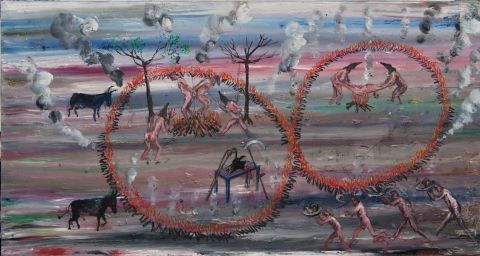- Venue
- Hauser & Wirth Gallery
- Location
- London
When I entered the Philippe Vandenberg exhibition my initial reaction was that of a sigh of relief. I was drawn to the uncompromisingly dirty marks, the clumps of paint, cracks and anti-slick style of his work. When confronted with imagery of sodomy and ritualistic killing I did not feel shocked or repelled rather I related it back to our history as a species which is entrenched in violence.
His work is embedded in folk, myth or fairy tale imagery with the big bad wolf and the horned bull making an appearance through several of his paintings. Ritualistic circles loom over naked figures caught burning flesh coloured bodies. This points us in the direction of pagan worship and of the history of magic and witchcraft. The figures in Now patience is flowering into death 2 reminded me of Marcel Dzama’s violent yet lovely paintings of figures with guns not just because of their violent nature but also because of the scale and frolicking behaviour of the figures. The landscape aspect in his work brought up images of Sidney Nolan’s paintings for their barrenness and Arthur Boyd for their religious narrative which Vandenberg explores in The Lion Shepherd.
No Title, finds the viewer overlooking a scene where a mauled figure lies on a bed surrounded by wolves watching over him mournfully yet hungrily. Some of the wolves are seated or lying down but watchful of an impending moment which has probably already passed. Here we see the double sided nature of mans best friend. The wolf dog has befriended the man yet its carnivorous nature has also consumed, much the same as painting befriends and then consumes the artist. This scene is centred in a background of white paint and brutal mark making, a reflection of the take me as I am attitude prevalent in his work.
Vandenberg is aware of the pleasure of life and the pain of death and embraces this. He does not hide behind pain numbing pastel colours nor does he wallow in surfacey slickness rather he opens the wound of life and lingers there feeling its power and succumbing to its enticement. When looking at To Love is to Flagellate II it is noticeable that the left hand side of the painting looks like a giant bruise, a black fire or a cancerous wound which leaves the viewer with the distinct feeling that the painter is not afraid to allow a painting to wander into territories of discomfort or painterly irresolution.
Perhaps pain and suffering in art belong in previous centuries but viewing these paintings came to me as a breath of fresh air in amongst the shininess of Mayfair. This if anything reminded me that within a diverse art world there is a place for all kinds of painting. If a painting can reach you in your gut then it has done its job, if it is too uncomfortable then you can always get back to bubblegum enriched pastel colours for comfort.
As Marc Ruyters makes clear in the press release Philippe Vandenberg comes from a time in art history where painters in Europe were revolting against the hegemony of American Conceptual art as seen in his ‘vehement and uncompromising’ Neo-Expressionist style. This is an example of how art regardless of style feeds into the ideas of other artists and how one style of art can and does enrich another purely from the reflection of its opposite.
We live in a time where the feeling heart of the artist can be replaced by the artist assistant who can help the artist to complete enormous amounts of work in his or her own lifetime. But when the hand of the artist is so alive in the emotion and experience of the work it is easy to place a reinforced value on the artist who lives and breathes within their own work created by their own hand.
I left the exhibition with the feeling of wanting to see more by this artist and his paintings lingered in my mind. Perhaps the shock value did work after all on my un-shockable disposition.
Text by Lisa McKendrick

